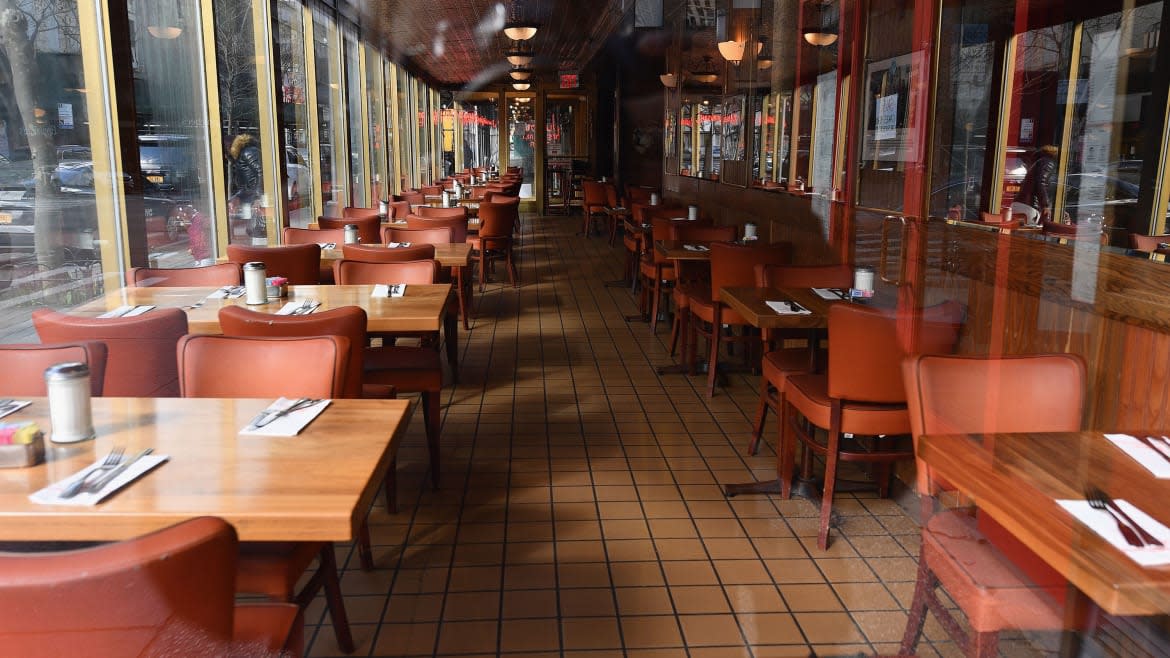Restaurants Fueled U.S. Recovery. Now Workers Are Devastated.

When the Labor Department reported Thursday that nearly 3.3 million people filed for unemployment for the first time last week, it put numbers behind an unprecedented, deliberate shutdown of America’s economy to rein in the 2019 novel coronavirus.
But one industry was hit harder than most.
“The layoffs in restaurants swamp anything we have ever seen,” said Dean Baker, senior economist with the Center for Economic and Policy Research, a progressive think tank. “In several large states, restaurants are being forced to shut down. Most are laying off their staff. This is probably two orders of magnitude larger than the worst weeks in the Great Recession.”
It also represented the near-instantaneous devastation of an industry that led the slow-but-steady economic recovery over the past decade. Between December 2009 and February 2020, the U.S. added 3.9 million leisure and hospitality jobs. That represented a 30 percent growth rate, compared with an 18 percent increase in overall employment. In terms of raw numbers, only health care added more jobs over that time. Baker said that not only was the industry growing fast, but, thanks to tight labor markets and state minimum wage hikes, its generally low wages were heading upward.
Still, average weekly earnings in the leisure and hospitality industry are just $435, and many restaurant workers didn’t have reliable, permanent full-time jobs even before the pandemic struck. That means some of the more precarious workers in what was already a deeply unequal economy are facing both short-term pain and long-term fear.
“It’s already an unstable industry to be in, and this is not helping,” said Carver Shields, 32, who’s been working in various bar and restaurant jobs in the Midwest for several years.
NYC Is on the Brink as Patients Flood Hospitals Already ‘Under Siege’
Shields said that, because some of his most recent work in Chicago had been on and off, including under-the-table gigs where he was responsible for paying his own taxes, he’s not sure if he’s even able to get unemployment benefits. He had been preparing to start a new job after a period of his own illness last month, but then Illinois officially closed down all its eating establishments. He now has no idea when the place may be open again or whether there will be work for him there when it is.
“I’m in limbo,” he said. “Since everyone who works there is in the same place and I’m just starting, everyone’s now like, ‘Whenever we open I want to pick up as much as possible.’”
While the rescue plan making its way through Congress should offer some support for unemployed restaurant workers—including at least some self-employed people—the future of their jobs is deeply in doubt. It’s unclear how long it will be until it’s safe for strangers to crowd together in a restaurant again, or how many shuttered establishments will ever reopen.
After all, it’s not exactly a secret that restaurants run on tight margins even when business is good.
“In many cases they barely scraped together enough money to get a place open,” said Aaron Allen, a food industry analyst. “They usually have a few days or maybe a few weeks of liquidity.”
Allen noted the federal relief package could force these businesses to take on large levels of debt to get the support they’d need to continue to make payroll. Adding to the economic uncertainty, the shutdowns are accelerating a shift toward delivery that was already surging in American life, he added. That makes it unclear how strong business will be once it’s safe to go back to in-person dining.
“It’s not like when the restaurants reopen that there will be so much demand that you could make up for this,” he said.
Maria Campos, a 57-year-old server at a steakhouse at LaGuardia Airport in New York, said she was laid off three weeks ago. She’s been approved for unemployment, but at least so far, it’s only slated to be $504 a week after taxes—and she hasn’t yet received the first check. That’s compared with the $800 to $900 she usually brought home weekly thanks largely to tips from diners. Her husband’s work as a taxi driver has also disappeared, and since he’s self-employed, he hasn’t been able to get unemployment benefits.
“I’m the only one that’s bringing in anything,” she said.
Campos said she’s not sure how she’ll pay next month’s bills. Her mortgage lender has said they don’t have to pay immediately, but the money will still come due eventually.
“I’m like, ‘OK, if I can’t, what’s going to make you think that I’m going to have the money saved to pay you back?’” she said.
More immediately, Campos expects to lose her health insurance at the end of March, and she said she can’t afford to pay for the COBRA or other insurance options she’s researched.
“I’ve worked for 30 years, I’ve been working at my job every day,” Campos said. “I’ve been through 9-11, I’ve been through storms like Sandy, but this one is different. It’s the whole world. It impacts everyone. How am I going to come out of this? I’m going to do the best I can.”
Got a tip? Send it to The Daily Beast here
Get our top stories in your inbox every day. Sign up now!
Daily Beast Membership: Beast Inside goes deeper on the stories that matter to you. Learn more.

